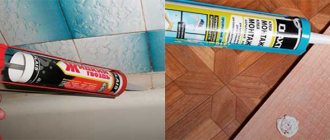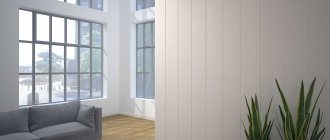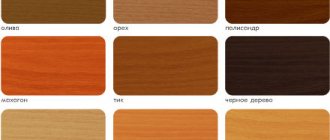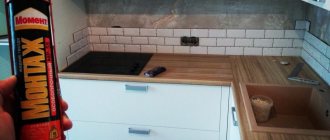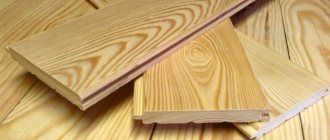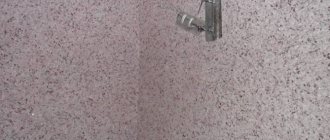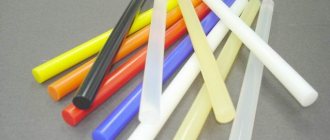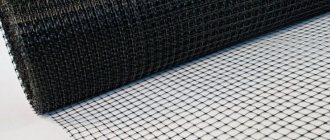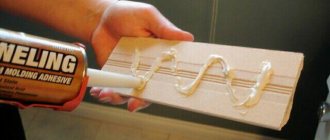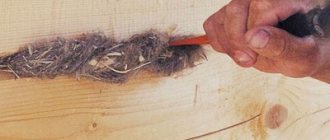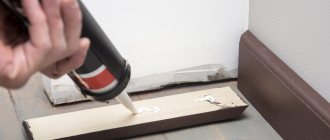How to work with the composition
Apply the composition to a surface that is degreased and free of all contaminants. The glue should be spread from the edge part at a distance of 2 cm; a layer should be applied to uneven bases in a dotted manner. For small objects, linear application is allowed; for better bonding, a snake distribution is done.
For small objects, linear application is allowed; for better bonding, a snake distribution is done.
Application rules
For the acrylic look, the parts are applied and pressed together for a given time. For rubber ones, you will need to press for a moment and separate the parts, which helps to ventilate the thinner. They wait 5-10 minutes, after which they finally secure the items together.
Excess parts of water-based glue are removed with a damp rag; for synthetic ones, the rag will need to be impregnated with a thinner. Or the dried parts are cut off with a sharp instrument.
They wait 5-10 minutes, after which they finally secure the items together.
Drying time
Since there are different compositions, the drying period also differs. Typically, initial setting lasts 25-30 minutes, and complete drying requires one day. You should study the instructions so as not to make a mistake with a specific product.
Typically, initial setting lasts 25-30 minutes, and complete drying requires one day.
Liquid nails Moment Installation are a good option for securing various materials under different operating conditions. A wide range can confuse beginners, but if you study the features of the division of categories described in the article, the choice will be easy.
Preparing the surface for work
Before starting work, prepare the surface. First, clean the area where you plan to apply the glue from various contaminants, grease, paint, and other things.
To achieve the desired effect, the surface is first treated with a special primer.
Before directly applying the glue, read the instructions for use and take into account the safety rules for working with the material, as it can be toxic. Particular attention is paid to what materials the glue is used for and how long it takes to dry.
Areas of application of the material
The structure of the adhesive is represented by an adhesive material, which is used by specialists in construction and other fields. The composition includes large quantities of fine fraction fillers, which ensure strong adhesion of the planes. After using liquid nails, the structure can withstand quite powerful loads.
To increase the flexibility of the material, it is possible to add a specific amount of white clay. But, it must be taken into account that such an application will slightly reduce the adhesion of surfaces.
The material is used not only in construction, but also in everyday life, which confirms its versatility. The glue is capable of gluing the following materials:
- wooden planes;
- plasterboard parts;
- plastic;
- plexiglass, glass;
- aluminum, teflon;
- cork natural surfaces;
- ceramics;
- planes made of fiberboard, chipboard, OSB;
- cellophane, etc.
There are also cases of using a mixture instead of a sealant. Using them, it is possible to produce high-quality sealing of bathrooms, doors, windows, recesses in the bathroom, furniture, walls, etc. When renovating premises, the composition is used for gluing heavy bamboo wallpaper and wooden elements. In this case, the glue is applied to the reverse side of the material and, after pressing it against the wall, lightly tapping it with your hand is performed. If excess mixture comes out from the side parts of the glued material, then you should not remove it immediately; it is better to wait until it dries and carefully remove it. Applying the composition for gluing ceramic tiles onto this liquid composition will significantly increase adhesion. But this method of application is expensive.
Liquid nails are not used for the purpose of adhesion of surfaces from damp and old wood, and products that are regularly used in water.
Extrusion from a gun
For a large amount of work, it makes sense to use a special gun, which will reduce product consumption and facilitate the application procedure. The principle of operation of pistol devices is similar to syringes; the entire body or half of the tube body can be inserted into the pumping structure; sometimes it looks like a skeleton on which a packaging container with glue is fixed.
The easy-to-use models feature reverse motion, which significantly speeds up gluing, which is especially important in industrial environments. When constantly performing large volumes of work with adhesives, it makes sense to use a gun that runs on electricity. The technical features of the units are indicated in the accompanying instructions, the reading of which should not be neglected.
Types of “Moment Montazh” adhesive according to the type of materials being glued
Liquid nails are created in large quantities, for this reason it can be difficult for buyers to choose the right type. One of the selection criteria is the material that is going to be glued.
One of the selection criteria is the material that is going to be glued.
How are they labeled?
To make it easier to choose the composition for the base, the products are divided into separate categories. The following options are available:
- For ceramic and metal bases, you can use all substances from the MP series; Express MV50 is suitable for indoor work;
- MP50 without amalgam in the composition is used for working with mirrors;
- For installation operations in rooms with high humidity, choose MB40, MF80 products, which differ in the properties of the sealant;
- For interior decoration - installation of skirting boards, ceiling parts, styrofoam panels, PVC, MV45 "Express Decor" is used, which has a white tint. And minimal shrinkage, which helps to achieve an unnoticeable fastening;
- For items with heavy weight, select “Super strong Lux”, MP35 “For panels”, “Extra strong” MP55.
For interior decoration - installation of skirting boards, ceiling parts, styrofoam panels, PVC, MV45 "Express Decor" is used, which has a white tint.
Purpose
The material possibilities of the “moment” are great. The material will glue wooden parts, plastic, light ceramics, plaster, cork, foam plastic.
Tube
Most often, MV-50 is purchased for gluing skirting boards, finishing parts for the ceiling, and corners. Suitable for gluing ceiling tiles.
With distributor
Consumption per square meter is about 20-400 grams. The calculation is made regarding the weight and materiality of the parts being glued together.
Important! Adhesive marked “express” is intended for lightweight modular parts. It is possible to use the described product at the specified consumption, subject to the weight limits of the material.
Types of glue by composition and technical characteristics
Glue Installation liquid nails can be created from two substances - a synthetic type or a water dispersion polyacrylate. This feature has a strong impact on the area of application; the first option contains solvents that affect the odor and harmfulness of the composition (marked with the letters MR), the second is more environmentally friendly - marked MB.
Glue Installation liquid nails can be created from two substances - a synthetic type or a water dispersion polyacrylate.
Based on synthetic resins
The synthetic base is well suited for installation work; it contains substances that are unsafe for human health, which requires use in rooms with good ventilation. The following technical characteristics can be distinguished:
- High degree of resistance to moisture, which allows use on objects that are constantly in contact with liquids;
- Typically selected as a sealant;
- You can glue structural parts to any base - concrete, brick, glass, wood, metal, PVC and chipboard;
- Copes with gluing sanded and non-porous materials;
- The layer is elastic and resistant to vibration.
Some types of liquid nails with a synthetic base can be used to work on polystyrene foam parts, but this property is rare, so you need to carefully study the instructions.
The synthetic base is well suited for installation work; it contains substances that are unsafe for human health, which requires use in rooms with good ventilation.
Based on polyacrylate-water dispersion
The advantage of this type is that it is water-based, which makes the composition harmless. At the same time, harm to fish is noted, which is the reason for the prohibition of disposal of the product into sewer systems. The properties note the following points:
- Does not emit an unpleasant odor;
- Increased level of adhesion;
- Suitable not only for gluing parts, but also to cover holes to level the base;
- Can be used indoors and outdoors, resistant to water;
- Can be painted over with dispersion types of paints;
- Fast rate of primary drying, time is indicated in the name using a number;
- You can change the location of glued parts within 15 minutes after they are glued;
- It is impossible to freeze the undried layer;
- Used at temperatures of +5-35 degrees;
- When sealed in its original packaging, the solution will be stored for 18 months.
- There are white and colorless types, the second option is marked with the letter P. Suitable for a variety of materials, including PVC.
The advantage of this type is that it is water-based, which makes the composition harmless.
